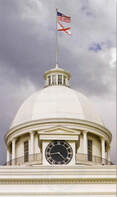 (Photo by Robin McDonald)
(Photo by Robin McDonald) The clock originated in Boston and was crafted by renowned clockmakers Howard & Davis. Edward Howard and David P. Davis began a partnership in Boston around 1847, making tower clocks under the name of Howard &
Davis. Howard likely made the capitol's striking tower clock, either in part or in a
supervisory capacity, and the Alabama capitol clock is considered to be a prized
example of early tower clockmaking in America prior to 1875. After that date, practically all tower clocks were mass-produced in an industrial fashion.
The Howard & Davis capitol clock was electrified in the 1930s; it no longer has the original gears, or the winding and striking mechanisms, but the essential gear-box armature frame is still intact, and it is believed to be one of
only twenty or so still in existence today. The timepiece's clock weights likely
still hang in the walls of the capitol due to the tautness of the weight-chains in the capitol attic. Also, the Howard & Davis striking tower clock was engineered to mechanically and perfunctorily strike the hour on a tower bell. Situated on the capitol's roof, between the clock and dome and under its own pavilion, the large 2,500-pound bronze clock bell glistens with chromatic colors visible through a cloudy patina developed over the course of practically 160 years. Though now silent, long ago the bell chimed the musical note 'E' in broad waves of sound heard up to two to three miles away. But the capitol bell has its own fascinating history with an authentic connection to one of the most important and famous figures of the American Revolution-Paul Revere. A clue to this connection can be found around the bell crown, where the aged block letters reveal the inscription:
"CAST BY HENRY N. HOOPER & COMPANY BOSTON 1850."
In 1821 grandson Paul Revere Ill partnered with master mechanic and
bellfoundryman William Blake to form "Revere and Blake;' being joined
shortly thereafter by John W. Sullivan and Henry N. Hooper in 1823 to
become "Paul Revere and Company,' with Hooper as the company agent.
In 1825 the business name changed to "Boston & Braintree;' and yet again to
"Boston Copper Company" until 1830, when Henry N. Hooper partnered
with William Blake and Thomas Richardson to form Henry N. Hooper &
Company (1830-1868), the very maker of the Alabama capitol bell.
Although the capitol bell is not technically one of the Revere bells,
which were only cast between 1792 and 1830 and bear the inscription of
the Revere name upon them, it was cast in the Revere foundry legacy and
tradition by individuals who quite possibly apprenticed under Paul Revere
himself or most definitely learned the craft under his sons and his grandsons.
Even today, the foundry is still referred to as the Revere-Hooper-Blake Foundry by bell historians and the Guild of Carillonneurs in North America.
Preservation of the bell and the clock would no doubt reveal a layer
of history that has never been widely known or presented before and would
add a new dimension to experiencing our state capitol and its historical
narrative. And certainly our children and theirs will appreciate the chance to
see a bell forged in Revere's foundry.
This feature was previously published in Issue 105, Summer 2012.
About the Author
Thomas Kaufmann is a Montgomery artist and preservationist. For more information, please visit www.thomaskaufmannart.com.
 RSS Feed
RSS Feed